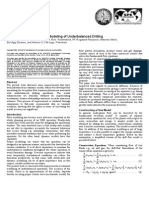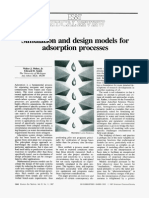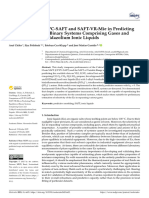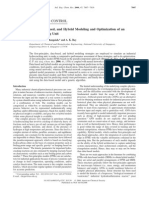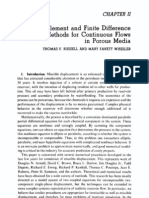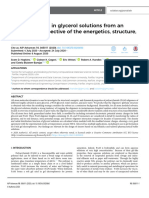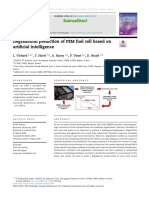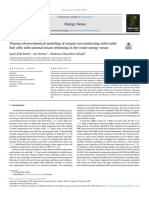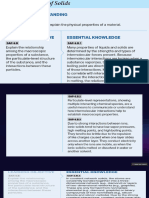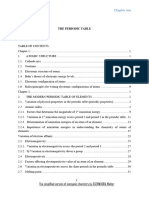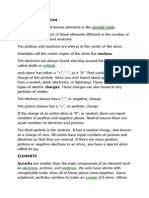Future Foods: Coding Caviar To Avoid Species Extinction
Future Foods: Coding Caviar To Avoid Species Extinction
Uploaded by
LadsCopyright:
Available Formats
Future Foods: Coding Caviar To Avoid Species Extinction
Future Foods: Coding Caviar To Avoid Species Extinction
Uploaded by
LadsOriginal Title
Copyright
Available Formats
Share this document
Did you find this document useful?
Is this content inappropriate?
Copyright:
Available Formats
Future Foods: Coding Caviar To Avoid Species Extinction
Future Foods: Coding Caviar To Avoid Species Extinction
Uploaded by
LadsCopyright:
Available Formats
Ed
g d or he e. lis rs em b e pu e ich is ngin y@ k ch E se .u hi al res .co , w mic : jc dia e e tc he ns in f C ptio inem o ri nl d re n c i ea tio bs ma m pp stitu , Su s@ co a n y. st e I .org hen fir th da e tep le to m tic by che el.s tce ar hly i . ig is t w t@ n w Th on ket ing: m uc is w rt d : a ve al Ad ri ito
the chemical engineer|issue 824|february 2010
future foods
coding caviar to avoid species extinction
CHEMICAL ENGINEERS WHO CHANGED THE WORLD | PROCESS SIMULATION | ARSENIC REMOVAL
PROCESS SIMULATION &CAREERS OPTIMISATION
tce
Mark Matzopoulos explains new physical property modelling techniques for strongly associating systems and polymers
hysical properties are at the heart of virtually every calculation performed by practising chemical engineers. The size of vessels, operating conditions, temperatures, energy requirements, safety limits and many other critical design and operating quantities all depend on the intrinsic properties vapour pressure, density and phase partitioning, for example of the fluids being processed. The last 20 years have seen significant research into advanced molecular thermodynamic methods aimed at improving the representation of pure component and mixture properties, making it easier to determine properties for new components and apply these within process modelling tools. Much of this effort centres on statistical associating fluid theory (SAFT). The SAFT approach allows many different thermodynamic properties of mixtures to be determined accurately based on models of molecules and their interactions. These are much more sophisticated than those used by more well-known techniques such as the cubic equations of state. The resulting fluid model can then be used to accurately predict a wide range of properties over a range of operating conditions. SAFT is particularly good for stronglyassociating systems, such as the azeotropic hydrogen fluoride-water mixture used in the production of refrigerants, aqueous solutions of non-ionic surfactants and even strong electrolyte solutions. It also accurately quantifies the behaviour of systems involving high molecular weight
No its not a caterpillar! The SAFT view of a nonionic surfactant made of five segments; smaller spheres indicate electron donor and acceptor association sites
thermodynamic methods is that because the underlying molecular model has a much more physically meaningful basis, SAFTs predictions can be extrapolated much more widely a particular advantage for systems where there is limited experimental data in components, such as polymer-gas systems the areas of operation being studied. all typically poorly represented by Also, traditional equations of state cannot conventional equations adequately represent the behaviour of of state. systems involving complex materials such as The development of SAFT has been given polar solvents, hydrogen bonded fluids and a strong focus at Imperial College London, polymers. SAFTs associating fluid approach where a team of around 25 are working which can account for the electrostatic, polar on molecular systems engineering (MSE) and other association forces that need to be funded by a 3.6m ($5.8m) EPSRC grant. considered provides an unprecedented The key focus of Imperials SAFT group, led capability for modelling such systems by George Jackson, Amparo Galindo accurately. and Claire Adjiman, is in One challenge that needs providing thermodynamic to be overcome is that of modelling tools for computational efficiency. industry. In typical process simulations, physical background properties are At its heart SAFT responsible for about is an equation of 70% of computational state, a term likely to time. The complexity send shivers down of the underlying the spine of any SAFT equations, chemical engineer which require solution who endured a course of a system of nonin thermodynamics. linear equations and SAFT embodies evaluation of its partial significant advances derivatives for every Water molecule showing over the traditional van property calculation, brings association sites der Waals equation or cubic additional demands as well engineering equations such as as potential robustness issues. Peng-Robinson, which are better suited to These are important concerns since a typical near-spherical molecules. simulation will involve thousands of calls to The main difference is that the SAFT the physical property package. equation is underpinned by a physically how it works realistic representation of the molecule that includes its shape, size and the interactions In SAFT, molecules are modelled as chains between molecules for example, hydrogen formed from spherical segments, and its bonding within a mixture. possible to add so-called association sites on the segments to treat as hydrogen bonds or The major advantage over other
odel M viour beha
february 2010 www.tcetoday.com 43
tce
PROCESS SIMULATION & OPTIMISATION
650 strongly polar interactions. The basic SAFT approach starts by describing ideal molecular behaviour in terms of the usual translational, 550 rotational and vibrational kinetic energy terms. The various non-ideal terms are T/K then introduced separately: terms for the 450 forces of attraction and repulsion between segments making up the molecules, chain bonding representing the contribution due to the formation of chains, and forces of 350 association for example, those resulting 0 0.2 0.4 0.6 WPEG from hydrogen bonds in aqueous mixtures. There are various implementations of Above: Closed loop regions of immiscibility the underlying SAFT model, which differ of aqueous solutions of PEG of molecular principally in terms of the mathematical weight from 2180 g/mol (smallest loop) to 1,020,000 g/mol (largest loop) representation of the molecule and the specific forms of the various contributions. For mixtures, predictions based on data The approach taken by the Imperial team fitted in one area of operation remain is known as SAFT-VR, where VR stands for valid over a wide range of operating states. variable range . For example, liquid-liquid equilibrium Key to the behaviour of molecules that behaviour can be predicted accurately form hydrogen bonds, such as water or the using parameters fitted solely against amine solvent MEA (monoethanolamine), is vapour-liquid data, decreasing the need for the definition of association sites electron complicated and often-unreliable laboratory donors or electron acceptors which are LLE measurements. used to quantify hydrogen bond formation This is the closest that we have come to between molecules. a truly universal tool for predicting pure Its these association sites that component and mixture properties , provide SAFTs unique says Jackson. What is more it capability in dealing predicts phase equilibrium with aqueous solutions, properties within a few percent surfactants and other for a vast array of complex strongly-associating systems. components, allowing engineers to design integrated and optimise approach processes that have Not only does SAFT SAFT ethanol never been able to simplify standard engineering benefit from the application design problems, it has opened up new of modern model-based approaches that could revolutionise the engineering techniques before. design of industrial processes. Because Parameters defining all the relevant properties models can be closely integrated quantities that define the model for a with process models its possible to given molecule for example, the number incorporate molecular-level decisions and diameters of spherical segments, the (including molecular architecture, number and type of association sites are microstructure, solvent selection, mixture estimated from experimental data. Typically formulation and so on) within the process this data includes saturated vapour pressure design procedure and take decisions and density measurements at different simultaneously rather than sequentially. temperatures. Where available, mixture data A new approach is to design molecules is also used. One of the Imperial teams main and processes hand-in-hand, so that the activities is to build the growing databank of whole system is optimal a significant pure component and mixture parameters. challenge because of the complexity of the other key advantages physical description and the wide range of length-time scales involved, says Adjiman. There are other advantages. For example, its possible to transfer parameters from The integrated approach is exemplified one molecule to another within the same by Imperials work on the development of class (for example, from n-alkanes to efficient and cost-effective solutions for CO2 polyethylene), thus reducing or eliminating capture a key component of most practical the need for measurement although, carbon abatement systems through says Galindo, good experimental data simultaneous optimisation of process and always helps. solvent design. Traditionally, decisions on
case study
The Imperial team worked with ICI and Ineos Fluor to apply SAFT-VR techniques to chemical processes for refrigerants such as the hydrofluorocarbons (HFCs) being used as replacements for the CFC refrigerants responsible for the depletion of ozone in the upper atmosphere. HFC production involves mixtures containing hydrogen fluoride (HF) which, because of the extremely strong association between HF and water molecules, are particularly difficult to characterise with standard thermodynamic methods. SAFT-VR provides an excellent description of the vapour-liquid and liquid-liquid equilibria in these systems, which was used to design and optimise operation of the HFwater separation process. At the other end of the molecular scale, SAFT-VR also provided an excellent description of the phase equilibria of aqueous solutions of hydrocarbons and micellar solutions of alkyl polyoxyethylene surfactants and polyethylene glycol (PEG) in work with BP Exploration, Schlumberger and ICI. These systems are key ingredients in numerous applications ranging from personal care formulations to enhanced oil recovery that can extend well lifetime by a factor of two or three. In a recent collaboration with the Borealis Group, SAFT-VR was used to analyse phase behaviour (adsorption) in gas phase polymerisation reactions. The analysis suggested that replacement of the inert nitrogen gas by less volatile n-pentane would significantly increase the catalytic activity of the reaction. Borealis has subsequently verified at bench scale a 30% increase in the yield of polythene compared to the conventional mixture, with no change required in the reactor conditions.
44
www.tcetoday.com
SAFT has opened up new approaches that could revolutionise the design of industrial processes
february 2010
PROCESS SIMULATION &CAREERS OPTIMISATION
solvents are taken first then the process is designed around the constraints posed by the solvent choice, potentially resulting in seriously sub-optimal performance. new approach known as SAFT-, a group contribution method that embodies the concepts of the original UNIFAC approach developed by Fredenslund, Prausnitz and co-workers in the 1970s and 80s, but applying the molecular model principles of SAFT. SAFT-is immensely powerful in terms of property prediction; once the basic functional groups defining a molecule have been characterised, pure component and mixture behaviour can be predicted very accurately with no need for experimental data-fitting whatsoever. Its early days for SAFT- says Jackson, , but initial results are very promising. We can predict mixture properties over a wide range of conditions without any data. This will significantly reduce the time and effort required to ensure accurate physical property calculations in a wide range of industrial process design projects in the future. The MSE group has just won a 150,000 Research Excellence award from Imperial that will be used to accelerate technology transfer to industry. tce Mark Matzopoulos (m.matzopoulos@ psenterprise.com) is coo of London-based process modelling software supplier PSE
tce
commercialisation
Imperial has licensed the software to Process Systems Enterprise (PSE), which has very close links with the chemical engineering community at Imperial (the company was an early spin-out of the college), and has a significant chemical industry user base and an already-large number of academic users of its software . SAFT-VR is already interfaced with PSEs gPROMS suite, and the company is offering free trials of the capability to selected gPROMS industrial users in the chemical and polymers sectors.
This is a tool that will significantly reduce the time and effort required to ensure accurate physical property calculations
reducing reliance on experimental data
Work at Imperial continues in a number of promising directions. Most of the research is related to refining the underlying molecular model, to make it as easy as possible to predict properties for existing and new molecules, and to make those properties as accurate as possible. One major area of research relates to a
ADVANCED CUSTOM MODELLING IN A FLOWSHEETING ENVIRONMENT
PSEs gPROMS provides unprecedented power for high-delity predictive modelling for any complex process or product, within a sophisticated owsheeting environment. And our expert ModelCare service helps you maximise return, whatever youre modelling.
Accelerate innovation Manage risk
Operations in UK, USA, Japan, Korea, Saudi Arabia and India. +44 20 8563 0888 www.psenterprise.com
february 2010
www.tcetoday.com
45
You might also like
- Applied Thermodynamics For Process ModelingDocument7 pagesApplied Thermodynamics For Process ModelingdhavalmpNo ratings yet
- Catalysts: Process Simulation For The Design and Scale Up of Heterogeneous Catalytic Process: Kinetic Modelling IssuesDocument33 pagesCatalysts: Process Simulation For The Design and Scale Up of Heterogeneous Catalytic Process: Kinetic Modelling Issuesjesus de jesusNo ratings yet
- DME Synthesis Via Catalytic Distillation: Experiments and SimulationDocument6 pagesDME Synthesis Via Catalytic Distillation: Experiments and SimulationediabcNo ratings yet
- Applications of Thermodynamics in MechatronicsDocument3 pagesApplications of Thermodynamics in MechatronicsScribdTranslationsNo ratings yet
- Experimental and Modelling Studies of Low Temperature PEMFC PerformanceDocument10 pagesExperimental and Modelling Studies of Low Temperature PEMFC PerformanceiocsachinNo ratings yet
- Powder Technology: Yu Che, Zhou Tian, Zhen Liu, Rui Zhang, Yuxin Gao, Enguang Zou, Sihan Wang, Boping LiuDocument17 pagesPowder Technology: Yu Che, Zhou Tian, Zhen Liu, Rui Zhang, Yuxin Gao, Enguang Zou, Sihan Wang, Boping Liuธีรสิทธิ์ กุศลส่งทวีNo ratings yet
- 1 s2.0 S036031992030077X MainDocument9 pages1 s2.0 S036031992030077X MainxorrudslaNo ratings yet
- A Hydrodynamics-Reaction Kinetics Coupled Model For Evaluating Bioreactors Derived From CFD SimulationDocument9 pagesA Hydrodynamics-Reaction Kinetics Coupled Model For Evaluating Bioreactors Derived From CFD SimulationcarloscarinelliNo ratings yet
- Belghait May 2018Document20 pagesBelghait May 2018Cherif SI MOUSSANo ratings yet
- An Advanced 1D Physics-Based Model For PEM Hydrogen Fuel Cells With Enhanced Overvoltage PredictionDocument28 pagesAn Advanced 1D Physics-Based Model For PEM Hydrogen Fuel Cells With Enhanced Overvoltage Predictionthyhs1414No ratings yet
- Modeling of Fixed Bed Catalytic Reactors: Computers & Chemical Engineering December 1985Document12 pagesModeling of Fixed Bed Catalytic Reactors: Computers & Chemical Engineering December 1985hanaNo ratings yet
- Fakouribaygi2015 PDFDocument11 pagesFakouribaygi2015 PDFLaiadhi DjemouiNo ratings yet
- Kinetic Modelling at The Basis of Process Simulation For Heterogeneous Catalytic Process DesignDocument31 pagesKinetic Modelling at The Basis of Process Simulation For Heterogeneous Catalytic Process DesignDanielle BarkerNo ratings yet
- Literature Review FluidizationDocument8 pagesLiterature Review Fluidizationea4hasyw100% (1)
- Reniers - 2019 - J. - Electrochem. - Soc. - 166 - A3189 Review and Performance Comparison of Mechanical-Chemical Degradation of LIbDocument13 pagesReniers - 2019 - J. - Electrochem. - Soc. - 166 - A3189 Review and Performance Comparison of Mechanical-Chemical Degradation of LIbJerry WuNo ratings yet
- IADC/SPE 81636 Improvements in Dynamic Modeling of Underbalanced DrillingDocument8 pagesIADC/SPE 81636 Improvements in Dynamic Modeling of Underbalanced DrillingJohnSmithNo ratings yet
- 2018 Ploner JrnlPwrSrcs ClassicalStatisticalMethodforAcceleratedTestingofSOFCDocument7 pages2018 Ploner JrnlPwrSrcs ClassicalStatisticalMethodforAcceleratedTestingofSOFCAndres CamposNo ratings yet
- Simulation and Design Models For Adsorption ProcessDocument11 pagesSimulation and Design Models For Adsorption ProcessAlbert BittencourtNo ratings yet
- Comparison of CP-PC-SAFT and SAFT-VR-Mie in PredictingDocument15 pagesComparison of CP-PC-SAFT and SAFT-VR-Mie in PredictingIlya PolishukNo ratings yet
- Thermodynamic Database For Multicomponent Oxide SyDocument33 pagesThermodynamic Database For Multicomponent Oxide SyArijit GhoshalNo ratings yet
- First-Principles, Data-Based, and Hybrid Modeling and Optimization of An Industrial Hydrocracking UnitDocument10 pagesFirst-Principles, Data-Based, and Hybrid Modeling and Optimization of An Industrial Hydrocracking UnitPratik BhagatNo ratings yet
- PEM ModelDocument33 pagesPEM Modelankitnewton98No ratings yet
- 1 s2.0 S0375650516000092 MainDocument12 pages1 s2.0 S0375650516000092 MainHebaNo ratings yet
- Modeling and Simulation of The Phase-Inversion Process During Membrane PreparationDocument16 pagesModeling and Simulation of The Phase-Inversion Process During Membrane PreparationshayanNo ratings yet
- Chapter 2Document72 pagesChapter 2Seun Sam AdetolaNo ratings yet
- Final B Cud ReportDocument37 pagesFinal B Cud ReportsubburajsNo ratings yet
- Spe 182660 PaDocument29 pagesSpe 182660 PaSanjay singhNo ratings yet
- Modeling of Fixed Bed Catalytic Reactors: Computers & Chemical Engineering December 1985Document12 pagesModeling of Fixed Bed Catalytic Reactors: Computers & Chemical Engineering December 1985sergioln001No ratings yet
- Molecules 28 01768 v2Document20 pagesMolecules 28 01768 v2Patrice PariNo ratings yet
- Bao2017 Article FullyImplicitSimulationOfPolymDocument26 pagesBao2017 Article FullyImplicitSimulationOfPolymxin shiNo ratings yet
- Polyacrylamide in Glycerol Solutions From An AtomiDocument10 pagesPolyacrylamide in Glycerol Solutions From An Atomisindico.wonderNo ratings yet
- Intro 5Document11 pagesIntro 5AlisaNo ratings yet
- 95b Me FlotDocument11 pages95b Me FlotAndersonRicraLuisNo ratings yet
- Energies 11 01985 PDFDocument17 pagesEnergies 11 01985 PDFali ahmadiNo ratings yet
- Li 2010Document13 pagesLi 2010O LNo ratings yet
- Mathematical and Experimental Modeling of Reverse Osmosis (RO) ProcessDocument14 pagesMathematical and Experimental Modeling of Reverse Osmosis (RO) ProcessrajNo ratings yet
- SPE 130768 Multi-Field Asset Integrated Optimization BenchmarkDocument19 pagesSPE 130768 Multi-Field Asset Integrated Optimization BenchmarkIndo UtamaNo ratings yet
- Advances in ChemEng, Vol32 - ChemEng Kinetics PDFDocument320 pagesAdvances in ChemEng, Vol32 - ChemEng Kinetics PDFliliherliantiNo ratings yet
- 1 s2.0 S2772427122000201 MainDocument11 pages1 s2.0 S2772427122000201 MainAPOORVA R GNo ratings yet
- eNRTL Parameter Fitting Procedure For BLDocument8 pageseNRTL Parameter Fitting Procedure For BLBinay AkhuriNo ratings yet
- Modeling Mixtures With PC-SAFT Insights From LargeDocument20 pagesModeling Mixtures With PC-SAFT Insights From Largecarlo83No ratings yet
- Advances in Benchmarking and Round Robin Testing For PEM WaterDocument14 pagesAdvances in Benchmarking and Round Robin Testing For PEM WaterMizanur RahmanNo ratings yet
- Problem StatementDocument5 pagesProblem StatementMreza JafariNo ratings yet
- Optimal Design of Experiments: For The Identification of Kinetic Models of Methanol Oxidation Over Silver CatalystDocument7 pagesOptimal Design of Experiments: For The Identification of Kinetic Models of Methanol Oxidation Over Silver CatalystisosicaNo ratings yet
- PaulaDocument23 pagesPaulatahaafar9999No ratings yet
- Wang Et Al - 2010 - A Hydrodynamics-Reaction Kinetics Coupled Model For Evaluating BioreactorsDocument9 pagesWang Et Al - 2010 - A Hydrodynamics-Reaction Kinetics Coupled Model For Evaluating BioreactorsJalcamNo ratings yet
- Modeling of Partial Segments in The Process of Gasification of Agricultural Biomass Modeliranje Dela Procesa Gasifikacije Poljoprivredne BiomaseDocument11 pagesModeling of Partial Segments in The Process of Gasification of Agricultural Biomass Modeliranje Dela Procesa Gasifikacije Poljoprivredne BiomaseMilan DjordjevicNo ratings yet
- Scale-Up of Reactive Distillation Columns With Catalytic PackingsDocument22 pagesScale-Up of Reactive Distillation Columns With Catalytic PackingsChristian Martinez CervantesNo ratings yet
- July 2015: Robert Brunet Daniel Cortés-BordaDocument12 pagesJuly 2015: Robert Brunet Daniel Cortés-BordaMuhammad Haris HamayunNo ratings yet
- 10 1016@j Fluid 2009 11 018Document8 pages10 1016@j Fluid 2009 11 018Khresna Anugrah Ksatria PNo ratings yet
- A Parametric Study of Layered Bed PSA For Hydrogen PurificationDocument16 pagesA Parametric Study of Layered Bed PSA For Hydrogen PurificationMateo PosadaNo ratings yet
- 2008 Minh AICHE PDFDocument9 pages2008 Minh AICHE PDFinf2014No ratings yet
- CFD Modeling of Chemical Reactors: Single-Phase Complex Reactions and Fine-Particle ProductionDocument20 pagesCFD Modeling of Chemical Reactors: Single-Phase Complex Reactions and Fine-Particle ProductiondavinciNo ratings yet
- Dynamic Modeling and Simulation of The Multi-Effect DistillationDocument11 pagesDynamic Modeling and Simulation of The Multi-Effect Distillationapdallhaied67No ratings yet
- A Simulation of The Kalgoorlie Nickel Smelter Flowsheet Using METSIMDocument6 pagesA Simulation of The Kalgoorlie Nickel Smelter Flowsheet Using METSIMOsvaldo NetoNo ratings yet
- BasicsDocument106 pagesBasicsraghukkkNo ratings yet
- Ozhan jOURNAL ANALYSYS CATALYTIC CONVERTER USING ANSYSDocument11 pagesOzhan jOURNAL ANALYSYS CATALYTIC CONVERTER USING ANSYSAhmad SulaimanNo ratings yet
- Diagnosis and Robust Control of Complex Building Central Chilling Systems for Enhanced Energy PerformanceFrom EverandDiagnosis and Robust Control of Complex Building Central Chilling Systems for Enhanced Energy PerformanceNo ratings yet
- Modeling and Simulation of Thermal Power Plants with ThermoSysPro: A Theoretical Introduction and a Practical GuideFrom EverandModeling and Simulation of Thermal Power Plants with ThermoSysPro: A Theoretical Introduction and a Practical GuideNo ratings yet
- Chapter 8Document32 pagesChapter 8Danilo Fronda Jr.No ratings yet
- Test No-1 - Mock Test Series - NEET - Phy - Chem - Bio QuestionsDocument21 pagesTest No-1 - Mock Test Series - NEET - Phy - Chem - Bio QuestionsJeny SharmaNo ratings yet
- By MUHAMMAD ILYAS Teacher Gorikote LRS & Javed Iqbal PDT Aku-Ied, PDCN For Edip Project of Aus-AidDocument14 pagesBy MUHAMMAD ILYAS Teacher Gorikote LRS & Javed Iqbal PDT Aku-Ied, PDCN For Edip Project of Aus-AidDijith JhansiNo ratings yet
- 3.3.5 Bonding in Matter ChemDocument7 pages3.3.5 Bonding in Matter ChemCarina Silva-RomeroNo ratings yet
- Organic Chemistry - Some Basic Principles and TechniquesDocument16 pagesOrganic Chemistry - Some Basic Principles and TechniquesAbhayNo ratings yet
- Chapter 3 DHDocument53 pagesChapter 3 DHVlad KaneNo ratings yet
- Periodic Table DPPDocument19 pagesPeriodic Table DPPUMA JoshiNo ratings yet
- 3.2 Properties of SolidsDocument19 pages3.2 Properties of Solidsroadtogloryfifa22rtgNo ratings yet
- 6 C15 Notes CH4 Chemical BondsSTEM StudentsDocument12 pages6 C15 Notes CH4 Chemical BondsSTEM StudentsDONNA JEAN ACOJEDONo ratings yet
- DPP P-BlockDocument13 pagesDPP P-BlockNCCA NCCANo ratings yet
- EnterMedSchool Biology Book-30Document628 pagesEnterMedSchool Biology Book-30SleoNo ratings yet
- Pharmaceutical Binders and Their Function in Directly Compressed TabletsDocument62 pagesPharmaceutical Binders and Their Function in Directly Compressed TabletsDr. Gunjan SarkarNo ratings yet
- CY3201Document4 pagesCY3201Kumar KeshavNo ratings yet
- Inorganic Chemistry (Well Organised)Document205 pagesInorganic Chemistry (Well Organised)AJ Sagg. Cann.No ratings yet
- Lesson 1 General Chemistry 2 Synchronous ClassDocument18 pagesLesson 1 General Chemistry 2 Synchronous ClassJustine FabieNo ratings yet
- Solution Manual For Essentials of Materials Science and Engineering 3rd Edition by Askeland and Wright ISBN 1111576858 9781111576851Document12 pagesSolution Manual For Essentials of Materials Science and Engineering 3rd Edition by Askeland and Wright ISBN 1111576858 9781111576851owenNo ratings yet
- Ikatan IonikDocument15 pagesIkatan IonikAniesa FithriaNo ratings yet
- TI 1279 Successful Use of Aerosil Fumed Silica in Liquid SystemDocument11 pagesTI 1279 Successful Use of Aerosil Fumed Silica in Liquid SystemGrandys PerwiraNo ratings yet
- Thermodynamics and ThermochemistryDocument34 pagesThermodynamics and ThermochemistryBIJAY GAUTAMNo ratings yet
- BAED-CHEM2122 General Chemistry 2Document9 pagesBAED-CHEM2122 General Chemistry 2Marvin100% (3)
- 2021 JC2 H1 Chemistry Prelim Anderson Serangoon Junior College With Answer PDFDocument89 pages2021 JC2 H1 Chemistry Prelim Anderson Serangoon Junior College With Answer PDFWang PingNo ratings yet
- Chemical Bonding PDFDocument14 pagesChemical Bonding PDFTai PanNo ratings yet
- NIOS Class 12 Chemistry October 2022 Past PaperDocument24 pagesNIOS Class 12 Chemistry October 2022 Past PaperthisNo ratings yet
- m1 PDFDocument17 pagesm1 PDFShravan KumarNo ratings yet
- CHEMISTRY BAMISE SS3 Mock EXAMDocument6 pagesCHEMISTRY BAMISE SS3 Mock EXAMPAUL VICTOR100% (3)
- Minerals 09 00372Document11 pagesMinerals 09 00372Robert MaddenNo ratings yet
- Crystalloche Istry of V-P-O Phases and Applxcation To CatalysisDocument28 pagesCrystalloche Istry of V-P-O Phases and Applxcation To CatalysisNoel ErkelenzNo ratings yet
- Structure of AtomDocument7 pagesStructure of AtomMera FunportalNo ratings yet
- Introduction To Molecular Orbital TheoryDocument15 pagesIntroduction To Molecular Orbital Theorynathanangelo254No ratings yet
- Chemistry Midterm Study GuideDocument19 pagesChemistry Midterm Study Guideapi-276796861No ratings yet















